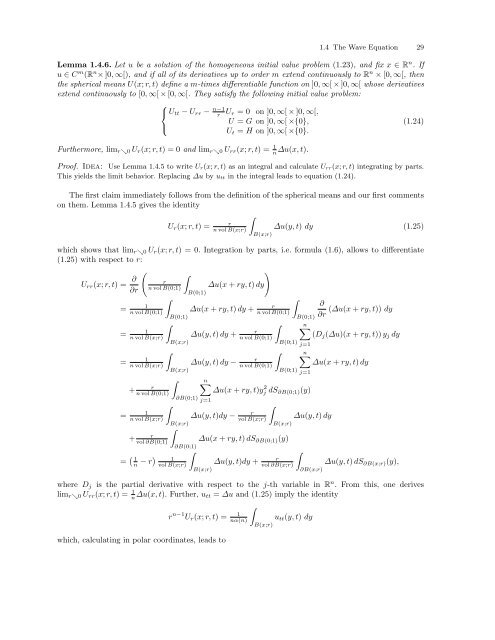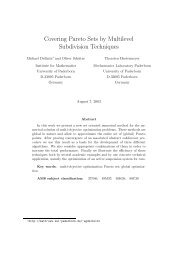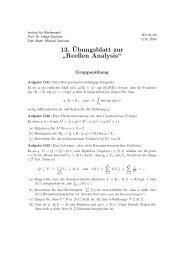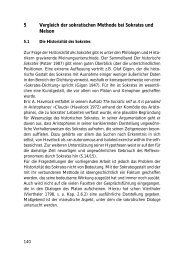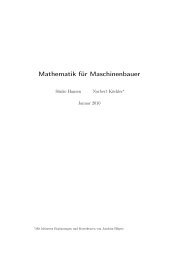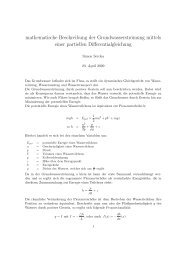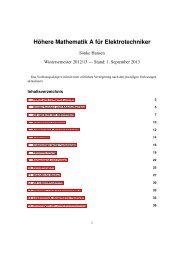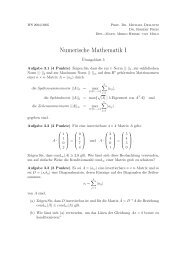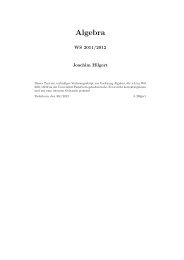Partial Differential Equations
Partial Differential Equations
Partial Differential Equations
You also want an ePaper? Increase the reach of your titles
YUMPU automatically turns print PDFs into web optimized ePapers that Google loves.
1.4 The Wave Equation 29<br />
Lemma 1.4.6. Let u be a solution of the homogeneous initial value problem (1.23), and fix x ∈ R n . If<br />
u ∈ C m (R n × ]0, ∞[), and if all of its derivatives up to order m extend continuously to R n × [0, ∞[, then<br />
the spherical means U(x; r, t) define a m-times differentiable function on ]0, ∞[ × ]0, ∞[ whose derivatives<br />
extend continuously to [0, ∞[ × [0, ∞[. They satisfy the following initial value problem:<br />
⎧<br />
⎨ U tt − U rr − n−1<br />
r<br />
U r = 0 on ]0, ∞[ × ]0, ∞[,<br />
U = G on ]0, ∞[ ×{0},<br />
(1.24)<br />
⎩<br />
U t = H on ]0, ∞[ ×{0}.<br />
Furthermore, lim r↘0 U r (x; r, t) = 0 and lim r↘0 U rr (x; r, t) = 1 n∆u(x, t).<br />
Proof. Idea: Use Lemma 1.4.5 to write U r(x; r, t) as an integral and calculate U rr(x; r, t) integrating by parts.<br />
This yields the limit behavior. Replacing ∆u by u tt in the integral leads to equation (1.24).<br />
The first claim immediately follows from the definition of the spherical means and our first comments<br />
on them. Lemma 1.4.5 gives the identity<br />
∫<br />
r<br />
U r (x; r, t) =<br />
n vol B(x;r)<br />
∆u(y, t) dy (1.25)<br />
B(x;r)<br />
which shows that lim r↘0 U r (x; r, t) = 0. Integration by parts, i.e. formula (1.6), allows to differentiate<br />
(1.25) with respect to r:<br />
(<br />
U rr (x; r, t) = ∂ ∫<br />
)<br />
r<br />
∂r<br />
n vol B(0;1)<br />
∆u(x + ry, t) dy<br />
B(0;1)<br />
∫<br />
∫<br />
1<br />
r<br />
∂<br />
=<br />
n vol B(0;1)<br />
∆u(x + ry, t) dy +<br />
n vol B(0;1)<br />
(∆u(x + ry, t)) dy<br />
∂r<br />
=<br />
1<br />
n vol B(x;r)<br />
=<br />
1<br />
n vol B(x;r)<br />
∫<br />
∫<br />
+<br />
r<br />
n vol B(0;1)<br />
∫<br />
1<br />
=<br />
n vol B(x;r)<br />
+<br />
r<br />
vol ∂B(0;1)<br />
B(0;1)<br />
B(x;r)<br />
B(x;r)<br />
∫<br />
∆u(y, t) dy +<br />
∆u(y, t) dy −<br />
∂B(0;1) j=1<br />
B(x;r)<br />
∫<br />
∂B(0;1)<br />
= ( 1<br />
n − r) 1<br />
vol B(x;r)<br />
∫<br />
r<br />
n vol B(0;1)<br />
r<br />
n vol B(0;1)<br />
∫<br />
B(0;1)<br />
B(0;1) j=1<br />
B(0;1) j=1<br />
n∑<br />
∆u(x + ry, t)yj 2 dS ∂B(0;1) (y)<br />
∆u(y, t)dy −<br />
∫<br />
∫<br />
r<br />
vol B(x;r)<br />
∆u(y, t) dy<br />
B(x;r)<br />
∆u(x + ry, t) dS ∂B(0;1) (y)<br />
B(x;r)<br />
∆u(y, t)dy +<br />
n∑<br />
(D j (∆u)(x + ry, t)) y j dy<br />
n∑<br />
∆u(x + ry, t) dy<br />
∫<br />
r<br />
vol ∂B(x;r)<br />
∆u(y, t) dS ∂B(x;r) (y),<br />
∂B(x;r)<br />
where D j is the partial derivative with respect to the j-th variable in R n . From this, one derives<br />
lim r↘0 U rr (x; r, t) = 1 n ∆u(x, t). Further, u tt = ∆u and (1.25) imply the identity<br />
∫<br />
r n−1 U r (x; r, t) = 1<br />
nα(n)<br />
u tt (y, t) dy<br />
B(x;r)<br />
which, calculating in polar coordinates, leads to


